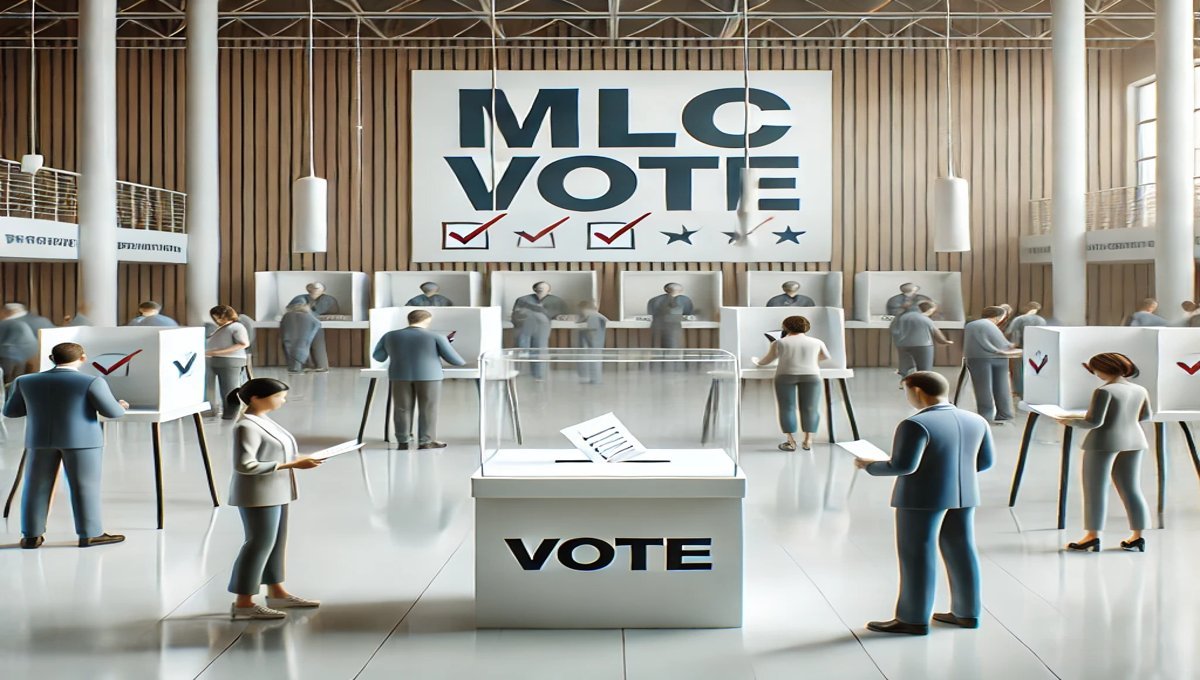MLC Vote: Everything You Need to Know About Member of Legislative Council Elections

Elections play a crucial role in shaping a democratic government, and among the various elections held in India, the MLC vote is a significant one. The Member of Legislative Council (MLC) vote is an important part of the bicameral legislative system in some Indian states. Unlike general assembly elections, where citizens directly elect representatives, the MLC vote follows a different electoral process involving local authorities, graduates, teachers, and legislative assembly members.
In this article, we will cover everything including its importance, eligibility criteria, voting process, and its impact on governance. Understanding the MLC vote will help citizens participate actively in democracy and make informed decisions.
Table of Contents
What is an MLC Vote?
The MLC vote refers to the election process through which Members of the Legislative Council (MLCs) are elected to the upper house of the state legislature in India. Not all Indian states have a Legislative Council; only a few, like Maharashtra, Uttar Pradesh, Bihar, Karnataka, and Andhra Pradesh, have a bicameral legislature.
The MLC vote differs from direct elections because it follows an indirect voting system. Various categories of voters, including members of the Legislative Assembly, local bodies, graduates, and teachers, participate in this election.
Importance of MLC Vote in a Democratic System
The MLC vote is a vital part of the democratic structure, ensuring that experienced professionals and knowledgeable individuals contribute to law-making. The Legislative Council acts as a revising chamber, providing expertise and a second opinion on the decisions made by the Legislative Assembly.
Key Roles of MLCs:
- Reviewing and suggesting amendments to bills passed by the Legislative Assembly.
- Providing a balanced perspective on policies and governance.
- Representing specific groups like teachers and graduates in the legislature.
- Ensuring that governance is not solely influenced by political majorities but also by expert opinions.
The MLC vote strengthens the legislative process by including voices from different sections of society, making governance more inclusive.
Who Can Vote in the MLC Elections?
Unlike general elections, where every eligible citizen can vote, the MLC vote is restricted to specific groups. The voters for MLC elections are divided into different categories:
1. Members of Legislative Assembly (MLAs)
- MLAs elect a portion of the MLCs through their votes.
2. Local Body Representatives
- Elected representatives of local bodies, such as municipalities and panchayats, participate in the MLC vote.
3. Graduates Constituency
- Individuals who have completed a graduate degree from a recognized university and meet the residency requirements can vote in the graduate MLC elections.
4. Teachers’ Constituency
- Teachers working in recognized educational institutions for a specified period are eligible to vote.
5. Governor’s Nomination
- The Governor nominates a certain number of MLCs based on their expertise in literature, science, arts, social services, or other fields.
Since the MLC vote involves a limited electorate, it ensures that experienced individuals with relevant backgrounds have a say in governance.
How Does the MLC Voting Process Work?
The MLC vote process varies depending on the category of the electorate. Here is a breakdown of how different groups participate in the elections:
Step 1: Announcement of Elections
The Election Commission announces the schedule for MLC elections, detailing nomination dates, polling days, and result declaration.
Step 2: Nomination of Candidates
Eligible candidates file nominations with the Election Commission. Candidates may be nominated by political parties or contest as independents.
Step 3: Campaigning
Candidates reach out to voters, presenting their vision and plans. Campaigning plays a vital role in influencing the MLC vote outcome.
Step 4: Voting Process
- For MLAs and Local Body Representatives: The MLC vote takes place through secret ballots or open voting.
- For Graduates and Teachers: Eligible voters cast their MLC vote at designated polling booths.
Step 5: Counting and Declaration of Results
After polling, votes are counted, and winners are announced based on the highest number of votes received.
The entire MLC vote process is conducted under the supervision of the Election Commission to ensure fairness and transparency.
Challenges and Controversies in MLC Voting
While the MLC vote plays an essential role in governance, it is not without challenges. Some of the common issues include:
1. Low Voter Turnout
The participation of graduates and teachers in MLC elections is often low, leading to concerns about proper representation.
2. Political Influence
There have been instances where MLC votes are influenced by political parties, leading to concerns over fairness.
3. Lack of Awareness
Many eligible voters, especially graduates and teachers, are unaware of their voting rights and the significance of the MLC vote.
4. Electoral Malpractices
Reports of vote-buying and manipulation in MLC votes have raised concerns about the integrity of the election process.
To strengthen the MLC vote, awareness campaigns and strict enforcement of electoral laws are necessary.
Why Should You Participate in the MLC Vote?
Active participation in the MLC vote ensures that qualified and experienced individuals contribute to law-making. By voting, you help:
- Improve governance by electing competent representatives.
- Strengthen democracy by making the legislative process more inclusive.
- Hold elected officials accountable for their policies and decisions.
If you are eligible to participate in the MLC vote, make sure to exercise your right and contribute to a better governance system.
MLC Vote Full Form
The full form of MLC vote is the Member of Legislative Council Vote. It is the process of electing representatives to the Legislative Council, which serves as the upper house in some Indian states with a bicameral legislature. The MLCvote helps ensure diverse representation in the legislative process by including professionals, educators, and local representatives.
MLC Voting Procedure
The MLC voting procedure varies depending on the category of voters involved. The process is designed to ensure fair representation from different groups, including Members of the Legislative Assembly (MLAs), local body representatives, graduates, and teachers. The MLC vote is conducted using a secret ballot system to maintain confidentiality and prevent undue influence.
Steps in the MLC Voting Procedure:
- Announcement of Elections – The Election Commission declares the schedule for the MLC vote, including nomination dates, polling, and result declaration.
- Nomination of Candidates – Eligible candidates file their nominations. They may be affiliated with political parties or contest as independents.
- Electoral Roll Preparation – Voter lists are prepared for different constituencies such as local bodies, graduates, and teachers.
- Campaigning – Candidates reach out to voters through meetings, debates, and advertisements.
- Voting Day – Eligible voters cast their ballots at designated polling stations.
- Counting and Declaration of Results – Votes are counted, and the winners are announced based on the highest number of votes received.
How to Vote in MLC Elections
If you are eligible to participate in the MLC vote, understanding the voting process is crucial. The voting process depends on the category you belong to (MLAs, local body representatives, graduates, or teachers). Voters must ensure they are registered and carry valid identification on the polling day.
Key Steps for Voting in MLC Elections:
- Verify your eligibility based on your constituency (graduate, teacher, or local body representative).
- Ensure your name is included in the electoral roll.
- Carry valid identification proof when going to vote.
- Follow the prescribed voting procedure at the polling station.
MLC Ko Kaun Vote Deta Hai?
One common question people ask is, “MLC ko kaun vote deta hai?” (Who votes for MLC?). Unlike general elections, where all citizens vote, the MLC vote is cast by a specific electorate, including:
- MLAs – They elect MLCs representing the legislative constituency.
- Local Body Representatives – Elected representatives from municipalities and panchayats vote for MLCs.
- Graduates – People holding a graduate degree and registered in the electoral roll can vote.
- Teachers – Teachers who meet the eligibility criteria and are registered in the electoral roll can vote.
Who Can Vote for MLC in Karnataka?
In Karnataka, the MLC vote is conducted as per the rules laid out by the Election Commission. The state has a bicameral legislature, and the voting process involves various constituencies.
Eligibility Criteria for MLC Voters in Karnataka:
- MLAs – Karnataka Legislative Assembly members participate in voting.
- Local Authorities Constituency – Members of local bodies such as municipal corporations and gram panchayats vote for MLCs.
- Graduates Constituency – Graduate voters must be residents of Karnataka and have completed their degrees at least three years before voting.
- Teachers’ Constituency – Teachers working in recognized institutions for at least three years are eligible.
Who Can Vote for MLC Elections in Telangana?
Telangana follows a similar voting process for MLC vote elections. The categories of eligible voters include:
- MLAs of Telangana elect some MLCs.
- Local body representatives such as municipal members and panchayat officials vote for MLCs.
- Graduates residing in Telangana and fulfilling eligibility criteria can participate.
- Teachers working in registered institutions with the required tenure can vote.
The MLC vote process in Telangana ensures that knowledgeable and experienced individuals contribute to the law-making process.
How to Register for MLC Vote in Telangana
To participate in the MLC vote, eligible voters must register with the Election Commission. Here is a step-by-step guide for registering as a graduate or teacher voter in Telangana:
Steps to Register for MLC Vote:
- Check Eligibility – Ensure you meet the criteria as a graduate or teacher voter.
- Collect Necessary Documents – Required documents include a degree certificate, proof of residence, and identification proof.
- Visit the Election Commission Website – Telangana voters can apply online through the state election commission’s official website.
- Submit Form 18 or Form 19 – Graduates must fill out Form 18, while teachers need to submit Form 19.
- Verification Process – The submitted documents are verified before approval.
- Receive Voter ID – Once approved, you receive confirmation, and you can participate in the MLC vote.
Ensuring timely registration is essential to exercise your right to vote in MLC elections.
Conclusion
The MLC vote is a crucial part of India’s legislative system, ensuring expert participation in governance. While it follows an indirect election process, its impact on law-making and policy decisions is significant. By understanding its process, and the role of MLCs, citizens can contribute to a more informed and democratic society.
If you are eligible, ensure that you register and take part in the MLC vote, as your vote can influence the future of governance in your state. Increased awareness and active participation will strengthen democracy and enhance the effectiveness of legislative councils in India.
You May also Read: E-shram Card Download: Benefits, Payment Status, Balance Check & Apply Online






